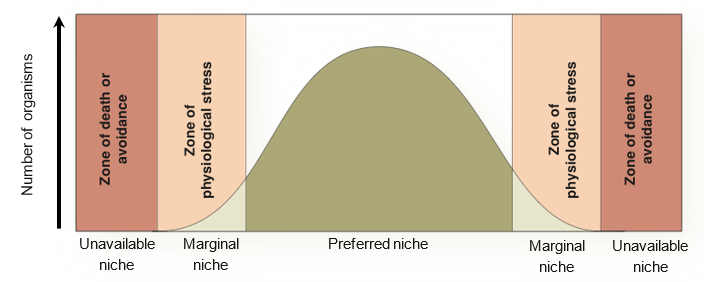2.1 Species and Populations
![By Steve Jurvetson (http://www.flickr.com/photos/jurvetson/226587515/) [CC BY 2.0], via Wikimedia Commons](/media/ib/ess/images/Small-Files/Hawk_eating_prey-wikipedia.jpg) Species and Populations
Species and Populations
To start this new unit I begin with some simple definitions then tackle the fundamental and realised niche. I find this brings students straight into the world of ecology, actively using words that can be hard to understand without a context.
I follow the niche work with some more definitions again followed by a practical activity on biotic interactions to start students thinking about species and population level interactions.
An exercise modelling population growth introduces S and J curves, carrying capacity and limiting factors and then to finish off the sub-topic there are practical activities for data analysis and thinking with wolves, climate change and Clark's Nutcrackers.
Recommended Teaching Time (not including practicals): 5 hours
Checking Understanding: Are Your Ready?
All these questions can be answered using the resources here and the sub-pages for 2.1.
- Define the terms species and population.
- Define the terms habitat and niche and give examples of each.
- Compare the terms fundamental niche and realized niche and provide an example.
- Outline the following abiotic factors that can affect a species distribution: temperature, sunlight, pH, salinity, precipitation.
- Use this diagram with an example to explain how an abiotic factor can affect the distribution of a species.

- Outline the following biotic factors that can affect species distribution: predation, herbivory, parasitism, mutualism, disease, competition.
- Give examples of intraspecific competition and interspecific competition.
- Describe how both intra and interspecific competition can affect niche size.
- Describe how competition can affect species diversity.
- Define exponential growth and draw an exponential (J-shaped) population curve.
- Draw and annotate a logistic (S-shaped) growth curve, be sure to address numbers and rates of growth.
- Define the term carrying capacity.
- Give two examples each of density independent and density dependent factors that can affect population size.
- Explain how density dependent factors are related to the logistic growth curve.
- Explain how predation, herbivory, parasitism, mutualism, disease, and competition can affect the carrying capacity of a population.
1. Fundamental vs Realised Niche
Significant Idea:
- A species interacts with its abiotic and biotic environments, and its niche is described by these interactions.
Student Tasks and Teaching Strategies
To start this sub-topic I have chosen to start with Introducing the Niche. This has been expanded upon since the last syllabus and now students are expected to understand the difference between a realised and a fundamental niche. I have found that this immediately has helped students to gain a deeper understanding of ecological concepts.
This is a definition heavy section of the course and so it is inevitable that many terms are defined and put into context.
As part of this first concept students develop case studies of different fundamental and realised niches. 1 2.1 Fundamental vs Realised Niches
2. Biotic Interactions
Significant Idea:
- Populations change and respond to interactions with the environment.
Student Tasks and Teaching Strategies
Students again need to learn a lot of definitions here and be able to identify the types of interactions that are occurring.
Try Biotic Interactions
3. Population Growth
Significant Idea:
- Populations change and respond to interactions with the environment.
- Any system has a carrying capacity for a given species.
Student Tasks and Teaching Strategies
I chose to teach the basics of population ecology next. It really is a matter of preference as to which order you teach these principles. I started by having students complete Modelling Population Growth. This meant that students produce two graphs, one of a yeast population which grows in a J shaped curve, exponentially, and then crashes, the second graph is S-shaped and shows a population reaching it's carrying capacity. At this point students are asked to come up with explanations for what might have happened to these populations.
The next step is to explore population interactions. Try Predator-Prey Interactions or Predator-Prey Simulations or Whitebark Pine Trees and Clark's Nutcrackers.
Finally we finished by returning to Yellowstone National Park and the an activity called Yellowstone National Park Wolves.
